Mistletoe - native (Amyema, Lysiana and Muellerina)
Family: Loranthaceae (Mistletoe family).
Mistletoes are hemi-parasites; they rely on the host plant for water and minerals, but have chlorophyll and are able to make their own sugars and other carbohydrates.
Mistletoes are important constituents of the local forests. They seldom kill their host; doing so would result in their own death. Studies (elsewhere) have shown that removing mistletoes reduces the biodiversity. Mistletoes are used by mammals, birds and insects for food and shelter. Some birds nest in mistletoe clumps where the dense foliage provides shelter. Dozens of butterflies are reliant on mistletoes for food.
Sometimes there can be excessive growth of mistletoe. This is a sign of a degraded environment and the natural predators of mistletoe (such as possums) are absent.
Mistletoe leaves frequently resemble the leaves of their host tree. One explanation for this is that this strategy makes it harder for birds that feed on mistletoe fruit to find the next mistletoe. This ensures that the birds visit numerous trees in search of mistletoe, and so spread the seeds more widely.
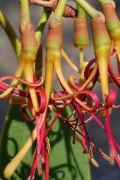 Box Mistletoe (Amyema miquelii)
Branchlets shiny, all flowers stalked. Very common.
Box Mistletoe (Amyema miquelii)
Branchlets shiny, all flowers stalked. Very common.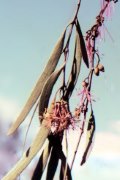 Drooping Mistletoe (Amyema pendula)
Branchlets dull, brown; central flower stalkless. Uncommon locally.
Drooping Mistletoe (Amyema pendula)
Branchlets dull, brown; central flower stalkless. Uncommon locally.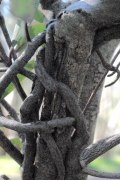 Creeping Mistletoe (Muellerina eucalyptoides)
Roots creep around branches. On Red Gums.
Creeping Mistletoe (Muellerina eucalyptoides)
Roots creep around branches. On Red Gums. 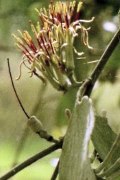 Grey Mistletoe (Amyema quandang)
Grey flat leaves. Flowers point upwards. On wattles. Uncommon.
Grey Mistletoe (Amyema quandang)
Grey flat leaves. Flowers point upwards. On wattles. Uncommon.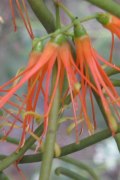 Wire-leaf Mistletoe (Amyema preissii)
Wire-like leaves. On wattles. Common.
Wire-leaf Mistletoe (Amyema preissii)
Wire-like leaves. On wattles. Common. 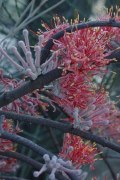 Buloke Mistletoe (Amyema linophylla)
Wire-like leaves. On Buloke. Uncommon. Baringhup.
Buloke Mistletoe (Amyema linophylla)
Wire-like leaves. On Buloke. Uncommon. Baringhup.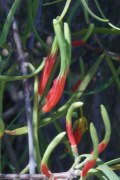 Harlequin Mistletoe (Lysiana exocarpi)
Narrow leaves (but not cylindrical). Never on eucalypts. Uncommon.
Harlequin Mistletoe (Lysiana exocarpi)
Narrow leaves (but not cylindrical). Never on eucalypts. Uncommon.